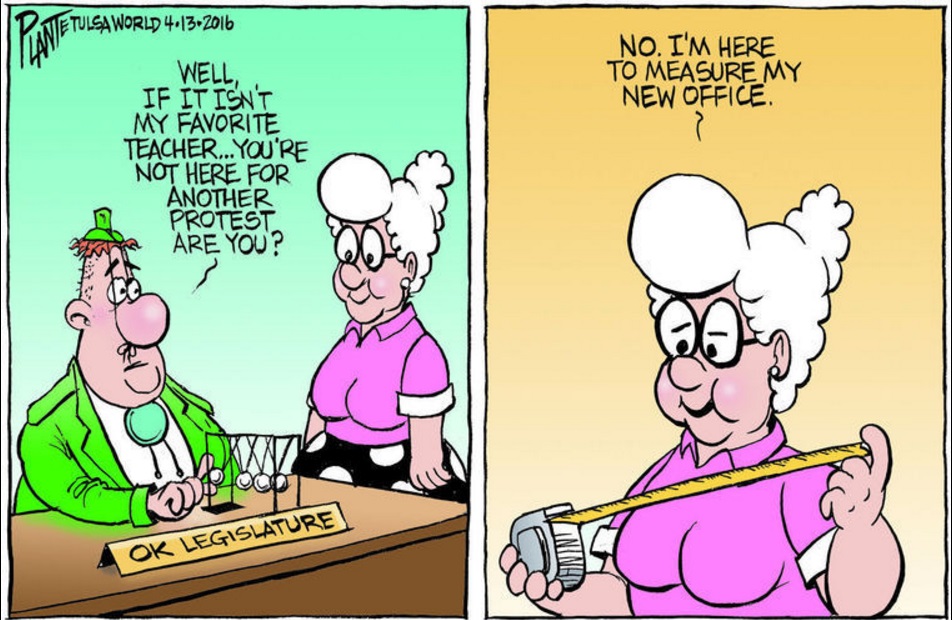 The Oklahoma GOP has for some time now held unchecked control of both the State Legislature and the Governor’s chair. Voters have handed them the keys, a 12-pack of Keystone, and encouraged them to have their way with the state. You’ve no doubt noticed the resulting prosperity trickling down all around you.
The Oklahoma GOP has for some time now held unchecked control of both the State Legislature and the Governor’s chair. Voters have handed them the keys, a 12-pack of Keystone, and encouraged them to have their way with the state. You’ve no doubt noticed the resulting prosperity trickling down all around you.
Each legislative season in recent years has seen a variety of proposals for some form of school vouchers, most recently called “Educational Savings Accounts” – a strange term for something which isn’t in an account and was never intended to be saved. Then again, neither clarity nor accuracy are real priorities of our current leadership. These are the same folks who believe “freedom of religion” means giving them the power to crush the infidel under their giant statue of Old Testament law, and who threatened to defund advanced history courses if we didn’t stop teaching about stuff that happened in the past.
Now that voters have made it clear how they feel about public education and the so-called “teacher caucus” which received so much attention this past election cycle, one has to assume the day of the voucher has arrived. We probably can’t stop it, but we can at least try to educate ourselves about it.
This is tedious stuff, folks. I’m sorry – I try to keep things festive here (at least when I’m not working myself towards a stroke during my almost daily fits of outrage and bewilderment), but I’m not sure that’s happening with this one.
Still, I’ll do my best. I guess I could throw in some bunnies or something.

There are two major issues with voucher programs. The first is whether or not they’re constitutional. That discussion has so far focused on a single question: Do vouchers violate the Establishment Clause by funneling public funds towards religious institutions? The short answer is no, they don’t – at least not in the cases addressed by the courts to date.
I’m not certain that should be the only question about their constitutionality, but I’m also just a humble classroom teacher with a blog, so what do I know?
The second issue is whether they’re a good idea. Unfortunately, there’s some disagreement about what this would even mean. I’m going to go with “are they good for kids?”
 Actually, this being Oklahoma, I should clarify further. “Are vouchers an effective way to provide a better education for a greater variety of students in a fiscally realistic way?” That’s how they’re promoted ‘round these parts, but I’m not at all convinced that’s the actual goal. (See earlier disclaimer about the humble guy with a blog.)
Actually, this being Oklahoma, I should clarify further. “Are vouchers an effective way to provide a better education for a greater variety of students in a fiscally realistic way?” That’s how they’re promoted ‘round these parts, but I’m not at all convinced that’s the actual goal. (See earlier disclaimer about the humble guy with a blog.)
The definitive Supreme Court case regarding “parent choice” and voucher programs is Zelman v. Simmons-Harris (2002). There have been others, but this seems to be the biggie. We’ll start by laying out the basics of this case, explain what the Supremes decided, and examine some highlights of the Court’s written opinions. Once that’s eliminated my last few readers, we’ll try to figure out if extant voucher programs in other states have actually made anything better, and if so, how. I hope to have this series concluded by Easter of 2019 or thereabouts.
If you haven’t read up on the origins of our proverbial “Wall of Separation,” how it came to apply to the states, or the major cases laying the foundation for school vouchers, you might want to start with those.
The devil, as they say, is in the details when it comes to constitutionality. On the other hand, details are boring. Let’s see if we can strike a workable balance – keep things readable while not making it too obvious that I’m not exactly a legal scholar.
Did I just say that out loud?

Cleveland schools were a mess. To be fair, Cleveland in general was a mess.
Area residents were still fighting desegregation as late as the 1980s. There were lawsuits and legislation and emotions were high all ‘round. In many cases, school segregation reflected community segregation – the poor Black folks lived in their parts of town, and middle and upper class whites lived in theirs. There were special committees, government-appointed directors and superintendents, and all sorts of bureaucratic efforts to equalize – at least in form.
Kids were bussed from their neighborhoods to schools across town, teachers were re-assigned with or without their druthers, reading and other remedial programs were mandated – and during it all, resentments remained well-stirred.
On paper there were positive signs. Schools became more integrated than they were before. There were more services theoretically available to high needs students. Districts offered targeted trainings for staff and teachers about dealing with students different than themselves. Many right things were said.
Heck, there were even a few structural and academic improvements documented.
 But you can’t legislate community buy-in, and you can’t mandate teacher satisfaction or require people to stay in the profession. The public wouldn’t pass bonds to pay for stuff, and district school boards wouldn’t make hard choices about cuts. Add school-board drama, conflicts over school closings and program cuts, and the ever-looming issue of racial equity, and despite many good people mostly pursuing what they thought was right, it just… they couldn’t…
But you can’t legislate community buy-in, and you can’t mandate teacher satisfaction or require people to stay in the profession. The public wouldn’t pass bonds to pay for stuff, and district school boards wouldn’t make hard choices about cuts. Add school-board drama, conflicts over school closings and program cuts, and the ever-looming issue of racial equity, and despite many good people mostly pursuing what they thought was right, it just… they couldn’t…
*sigh*
Per-pupil costs soared while effectiveness again fell (there’s one for you “can’t just throw money at a problem” folks). By the early 1980s, the schools were still largely segregated, teacher strikes were becoming far too common, and academic achievement was simply… not happening.
In 1985, the Superintendent of Cleveland Public Schools committed suicide in his office, leaving behind a note indicating his despair about ever fixing the problems around him or resolving the bitterness complicating it all. He was found by a student before school the following Monday, yet another poignant reminder of who exactly was suffering most from the personal and political fallout.
The drama and conflict continued.
By the 1990s there was talk of state take-over and redistribution of state funding so that wealthier school districts could be tapped to help prop up poorer ones. It was as part of this discussion that vouchers seriously came into play. Right around that same time, state courts found that Cleveland Schools couldn’t account for all of their state funding. They ordered 14 schools closed to help slow swelling deficits.
I share all of this because the second half of the 1990s saw the introduction of vouchers in a big way into Cleveland. This produced resistance from teachers and other organizations, and the issue ended up in the Supreme Court. Cleveland’s vouchers plan was declared constitutional, and nearly fifteen years later remains the law of the land in regards to such programs.
Why Does The Background Matter? Good question. It might not.
But this was a pretty specific set of circumstances, and details can make all the difference when it comes to constitutionality. It’s also worth remembering that just because something is technically constitutional, that doesn’t mean it’s a great idea. What might have made sense for Cleveland twenty years ago isn’t automatically ideal for Oklahoma (or anywhere else) today.

I confess a certain amount of paranoia when it comes to Oklahoma’s entrenched elite. It’s not inconceivable that a legislature hoping – for reasons of their own – to push through a voucher plan able to pass constitutional muster might do their best to establish similar circumstances to those in the marquee case legitimizing their use. One might even argue that years of slashing funding and shaming educators is part of an overall push towards privatization – that state leaders have been creating a crisis to justify their solution, not seeking a solution to their crisis.
You know, if you were cynical or something.
In any case, it’s worth taking a close look at how the Supreme Court framed the issues in Cleveland, and not only what they decided, but why.
RELATED POST: Let’s Talk About Vouchers, Part Two (Zelman v. Simmons, 2002)
RELATED POST: Let’s Talk About Vouchers, Part Three (The Majority Opinion in Zelman)
RELATED POST: A Wall of Separation – Vouchers Approacheth
RELATED POST: I’ll Support Vouchers (If You’ll Support Parent Choice)
RELATED POST: Better Basketball Through Vouchers


 In a few days, Oklahoma will
In a few days, Oklahoma will 
 Of course, lower courts generally defer to decisions from higher courts – that is, after all, the whole idea – and the 10th will no doubt follow the lead of the Supreme Court if they think the case before them is comparable to something previously decided. But if there are critical differences in the details – and there are almost always critical differences in the details – things might easily go the other way.
Of course, lower courts generally defer to decisions from higher courts – that is, after all, the whole idea – and the 10th will no doubt follow the lead of the Supreme Court if they think the case before them is comparable to something previously decided. But if there are critical differences in the details – and there are almost always critical differences in the details – things might easily go the other way.  Haskell County, Oklahoma, had a Ten Commandments monument on their Courthouse lawn, along with several pieces honoring military veterans of various wars. James Green, a local resident, believed the monument violated the separation of church and state. With the help of the ACLU, he sued to have the monument removed.
Haskell County, Oklahoma, had a Ten Commandments monument on their Courthouse lawn, along with several pieces honoring military veterans of various wars. James Green, a local resident, believed the monument violated the separation of church and state. With the help of the ACLU, he sued to have the monument removed. Needless to say, Oklahoma’s efforts are very much of the latter sort. Only quite recently have proponents begun trying to pretend they want anything other than to be ‘King of the Religious Mountain’ with this issue.
Needless to say, Oklahoma’s efforts are very much of the latter sort. Only quite recently have proponents begun trying to pretend they want anything other than to be ‘King of the Religious Mountain’ with this issue.  In about a week, Oklahoma will
In about a week, Oklahoma will  It’s difficult to say which has historically done the greater damage – a government that oppresses religion or a government that supports it. The first tends to end very badly for temporal authority; the latter tends to undermine the faith so favored.
It’s difficult to say which has historically done the greater damage – a government that oppresses religion or a government that supports it. The first tends to end very badly for temporal authority; the latter tends to undermine the faith so favored.  The Alabama Justice lost his position over his refusal to remove the monument. In Tennessee the issue bounced around a bit until the county sheriff agreed to relocate the Commandments from the lobby to his office – still government property, but less ‘public,’ I suppose.
The Alabama Justice lost his position over his refusal to remove the monument. In Tennessee the issue bounced around a bit until the county sheriff agreed to relocate the Commandments from the lobby to his office – still government property, but less ‘public,’ I suppose.  The district court didn’t get past the first question. There was no secular legislative purpose, so bang – you lose. Thanks for playing, Kentucky – sucks to suck.
The district court didn’t get past the first question. There was no secular legislative purpose, so bang – you lose. Thanks for playing, Kentucky – sucks to suck.  The Ten Commandments monument itself incorporated traditional American iconography – an eagle grasping the American flag and an eye inside of a pyramid – as well as two Stars of David and the superimposed Greek letters Chi and Rho, which represent Christ.
The Ten Commandments monument itself incorporated traditional American iconography – an eagle grasping the American flag and an eye inside of a pyramid – as well as two Stars of David and the superimposed Greek letters Chi and Rho, which represent Christ.  I don’t write many posts about Bible stuff, or faith in general. As incoherent as my posts may be, I try to remain tethered to topics at least remotely related to public education.
I don’t write many posts about Bible stuff, or faith in general. As incoherent as my posts may be, I try to remain tethered to topics at least remotely related to public education. It’s an obsession which seems to directly counter the entire point of the New Testament. An obsession specifically condemned by the central figure of that more recent Covenant, and after whom their faith is generally named.
It’s an obsession which seems to directly counter the entire point of the New Testament. An obsession specifically condemned by the central figure of that more recent Covenant, and after whom their faith is generally named.  According to the book of Genesis, God started mankind out with much to enjoy and to do, and a single rule not to eat fruit from one particular tree. The very first temptation by the earliest manifestation of ‘Satan’ began by questioning this lone prohibition – “Did God REALLY Say…?”
According to the book of Genesis, God started mankind out with much to enjoy and to do, and a single rule not to eat fruit from one particular tree. The very first temptation by the earliest manifestation of ‘Satan’ began by questioning this lone prohibition – “Did God REALLY Say…?”

 The New Testament and the arrival of Jesus Christ instead offered freedom – from the hierarchical structure of the Old Testament system, from rituals and sacrifices, and from the bondage of sin itself. The problem with freedom, though, is that you’re free. You have to figure things out and sort through options yourself. That’s great, in theory, but also terrifying and disorienting.
The New Testament and the arrival of Jesus Christ instead offered freedom – from the hierarchical structure of the Old Testament system, from rituals and sacrifices, and from the bondage of sin itself. The problem with freedom, though, is that you’re free. You have to figure things out and sort through options yourself. That’s great, in theory, but also terrifying and disorienting.  Remember the rush of shared victory you feel when your favorite team wins an important game, or the release of dopamine when you finally get past that nest of mercenaries on your X-box, and apply it to your eternity-shaping spiritual paradigm.
Remember the rush of shared victory you feel when your favorite team wins an important game, or the release of dopamine when you finally get past that nest of mercenaries on your X-box, and apply it to your eternity-shaping spiritual paradigm.  Instead we’re exhorted to “take up our cross” and follow Him – and as a bonus, if our hearts are truly pure, men will revile and persecute us and we’ll suffer a bunch, then die! We’re even specifically warned away from anyone who looks like things are going pretty well for them or who claims to have God’s will all figured out.
Instead we’re exhorted to “take up our cross” and follow Him – and as a bonus, if our hearts are truly pure, men will revile and persecute us and we’ll suffer a bunch, then die! We’re even specifically warned away from anyone who looks like things are going pretty well for them or who claims to have God’s will all figured out.  The New Testament simply doesn’t lend itself to the sorts of things politics are good at, or that people naturally want to be a part of. The Old Testament is a much easier model to emulate, and a far more entertaining system in which to be on the “right side” – preferably wreaking havoc on the “wrong.”
The New Testament simply doesn’t lend itself to the sorts of things politics are good at, or that people naturally want to be a part of. The Old Testament is a much easier model to emulate, and a far more entertaining system in which to be on the “right side” – preferably wreaking havoc on the “wrong.” 


